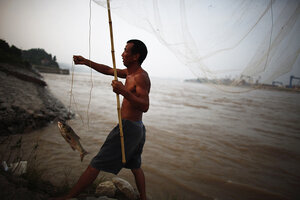Fish farming could be solution for food sustainability, report finds
Aquaculture, or fish farming, would have to more than double to cover future fish demand, a working paper from researchers at several institutions says. There are benefits to pumping up fish farming, such as employment opportunities, but it could lead to water pollution and damage to ecosystems.

A local resident catches a fish at the Yangtze River in Yichang, Hubei province August 9, 2012. Aquaculture, or fish farming, could be a sustainable solution for feeding the world, especially in densely-populated Asian countries.
Carlos Barria/Reuters/File
Improving Productivity and Environmental Performance of Aquaculture, the fifth installment of the '2013-14 World Resources Report: Creating a Sustainable Food Future,' was released in early June.
The working paper, produced by the World Resources Institute (WRI), WorldFish, the World Bank, INRA (France), and Kasetsart University (Thailand), is part of a series of papers to be rolled out throughout the year that focus on strategies to feed a global population of nine billion by 2050.
The series focus on a number of different “menu items”—strategies highlighted by the WRI as solutions to global food system problems— that are both “practical and scalable.” Menu items include: reducing food loss and waste, boosting crop yields, shifting agriculture to degraded lands, and increasing aquaculture’s productivity.
Richard Waite (WRI), Michael Phillips (WorldFish) and Randall Brummett (World Bank)—three of the paper’s authors—introduced the newest report in a live seminar.
“The wild fish catch has peaked,” informed Waite, and “this catch is not sustainable as about 30 percent of fish stocks are currently being fished beyond their biological limit.”
Aquaculture, or fish farming, has emerged in response to overfishing the world’s oceans as well as to meet the rising demand for fish, particularly in Asia. Waite highlighted that 90 percent of aquaculture is currently in Asia and that the bulk of the growth will continue to be in developing countries.
Waite posed the question, “how big will aquaculture have to get to feed an increasing global population?” Current aquaculture production will have to more than double to cover the growth in future fish demand, Waite stated.
Waite admitted this growth could be a double-edged sword; on the one hand, there are positive economic (employment opportunities) and environmental (farmed fish convert feed much more efficiently than other animal products) benefits associated with the growth of aquaculture. However, Waite highlighted that aquaculture also creates environmental impacts of its own, including water pollution, disease, and damage to ecosystems.
The team modeled the environmental impacts of eight different growth scenarios of aquaculture to 2050. Phillips admitted that keeping the environmental impacts at 2010 levels will be a challenge, but there are many options to reduce the impacts by managing tradeoffs between the land, feed, and water use.
Brummett informed the increases in aquaculture should not be a corporate undertaking, but also reminded there are inherent problems in attracting investment to small-scale operations. “Small is beautiful, but complicated,” according to Brummett.

